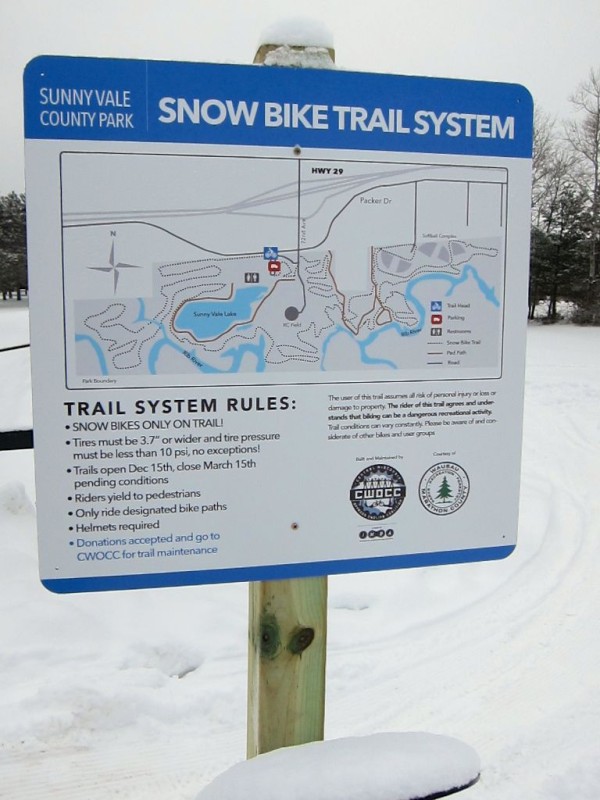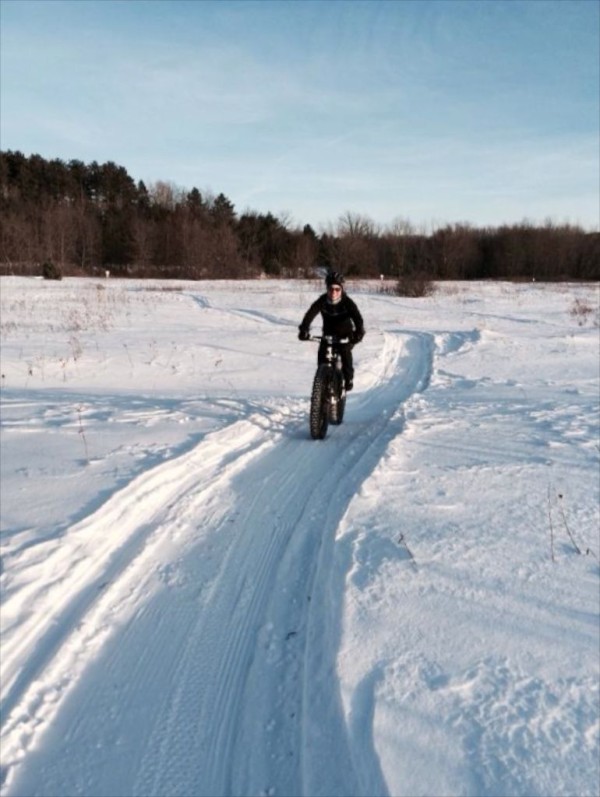A few weeks back, on the way home from the Midwest Fatbike Summit and Grooming Seminar a way up there in Cable, WI, Puck and I stopped at one of the trails we discussed at the Summit, Sunny Vale County Park in Wausau. The trail had been groomed that morning and conditions were great. The trails at Sunny Vale are specifically made for fat-bikes only and, in fact, the trails only exist in winter with riding available from December 15th through March 15th.
Sunny Vale was the site of the 2014 Wisconsin Badger State Games Fatbike Race; the first of its kind in the statewide competition.
Just a word about grooming before we get into the discussion of how Sunny Vale came to be the success that it is. We’ve seen a bunch of comments about grooming and how you could just ride a normal MTB on these groomed trails. Baloney I say! While it is true that under some circumstances MTBs can be ridden on heavily trafficked trails, the winter specific trail we are discussing here is NOT ridable on a normal mountain bike! Not even worth trying. In fact, one of the rules of the trail is 3.8” or wider tires and that is there for a good reason, MTBs simply don’t have enough float and tear up the trail.
There were a couple of mountain bikes that attempted the Inaugural Fat-bike Birkie last year and those guys were miserable on what is arguably the best groomed XC Ski Trail in the country and on which fat-bikes absolutely ROCK! One of the guys who finished said “Never Again! I’m getting a fat-bike!”. This year there is not even an MTB class in the Fatbike Birkie. A conventional MTB is simply not the right tool for the job!
Anyway, we contacted the Central Wisconsin Offroad Cycling Coalition to discuss the Snow Bike trails at Sunny Vale County Park in Wausau, WI. Bob Dunahee (BD) (CWOCC Board VP) and Gary Barden(GB) (CWOCC Board Pres) tag teamed the answers to our questions and have a lot of great ideas about how to make a successful Snow Bike trail system because they have down just that at Sunny Vale!
FB.c – What is the history of gaining trail access for fat-bikes in your area?
GB – We have been trying for about 2 years to get snow bike trails in our our local, spring, summer, fall mountain bike trail system. We got push back from other winter user groups as well the County thinking that the user population was getting too thick. We had a board member suggest Sunny Vale County Park, which in the winter, had very few users and the land used was old river beds that were wet for most of the year. We thought it would be a perfect place to create trails in the winter.
FB.c – Were efforts made to share existing trails with other users, gain access for fat-bikes only or a combo of the two?
GB – As a club, we initially considered sharing the trail with snowshoers. Many trail systems in our area were doing it, so we thought it would work for us as well. That was shot down pretty fast. Beyond that we never considered sharing a trail with any other user group. We wanted to share the park system and the land that was being used in the winter, but not the same trail. We knew there would be conflicts and safety issues having multiple user groups.
FB.c – What was the process for gaining the eventual acceptance of the trail? Did you have to present a specific plan etc.?
GB – Our club drew up a detailed professional presentation with a rough map, rules and regulations, grooming techniques and general information about snow biking. Once the County agreed, a land contract was drawn up concerning liability concerns, trail clearing, using chain saws etc.
FB.c – What land manager(s) did you need to work with?
GB – CWOCC worked directly with Bill Duncanson, Parks Director for the Marathon County Parks, Recreation, and Forestry Dept, and Ken Krueger.
FB.c – When trail use was approved for fatbikes were you able to use an existing network of trails or did you need to start from scratch?
GB – Once we got the green light, we had to start from scratch. In a 2 month window, we flagged the trail, got crews out to clear logs and trim back brush, produced and hung signage, got a snowmobile and had a club member construct a groomer for us and then waited for the snow!
FB.c – Now that the trail is approved and usable are there specific requirements for riding the trails? Rules of the road, so to speak.
GB – Very basic rules, 3.8″ or wider tires with a tire pressure of 10psi or lower, yield to pedestrians, wear a helmet, and stay on the trail.
FB.c – Is there a user fee for the trails? If so, how much?
GB – Suggested donations of $3 per rider or $25 per season. All of the proceeds go back into the groomer, covering maintenance and gas.
FB.c – How did you raise the money to purchase their equipment, signage or anything else associated with the winter trails?
GB – Our club had some money in the hopper that was earmarked for the initial setup. We also had a snow bike raffle that helped fund our efforts as well.
FB.c – Do your fat-bike trails allow other users like XC skiers, snowshoers, dog walkers etc.?
BD – When we initially approached the county for permission to build the trail, we thought by allowing different user groups access, they would see it as a positive to help give us the go ahead. Instead, they came back and suggested that because of past user group conflicts in other trail systems, they would like Sunny Vale to be a fat-bike only trail. We are posting signage to keep other users off the trail, but we still have dog walkers creating minimal the damage–it is a park.
FB.c – Do you groom the trails and, if so, how? Human-powered, mechanized or both?
BD – We decided the only way groom efficiently is to use a snowmobile. It has really paid off this year with the amount of snow and wind we’ve had.
FB.c – Can you get into a bit of the specifics on the equipment you use?
BD – Our main groomer was made by a club member and is basically a 24″ wide pan style with 200 pounds of weight for compaction. Early this winter, our snow didn’t have a lot of moisture because of the cold temps, so we where having a hard time getting the groomed surface to set up so we added combs to the groomer. I did an “unscientific” side by side test with another groomer without the combs. The groomer with the combs seem to setup the snow a lot faster. The combs seem to help fill in foot traffic holes as well and helped the groomer to track better. We also are experimenting with a plow which is working great and saves on the snow setup time. Another groomer we have been developing is one that cuts the top inch off of the base and then levels it which helps to fill in foot traffic or ruts when snow fall is lacking. There is a lot to learn, but it’s fun and actually a little addicting trying to figure it all out.
FB.c – What specific challenges do you face when grooming your system? This could be snow type or amount, trail width, use restrictions etc.
BD – When we first laid out the trail system we designed it like a mountain bike trail. About 100 yards into it, we realized that doesn’t work. We needed to redesign it to be more snowmobile friendly. It wasn’t so much the tight turns, but anything off camber on the flats and uphill that made it difficult to pull the groomer. Also, when grooming, we needed to do certain sections against the flow of traffic just to be able to make it with the snowmobile. Next year, we are hoping to remedy this by opening up new sections that where unreachable before with the purchase of a different snowmobile, one that is designed for pulling. My advice to any club looking to build and groom a fat bike specific trail system is to stay out of the open fields and any areas that are prone to snow drifting, it will make your groomers job much easier and help to maintain a better trail system.
FB.c – How many miles of groomed access is available for fat-bikers on your trail network?
BD – Right now we are at about 7 miles and hoping for 10 miles next year with the added snowmobile and possibly a boardwalk or two.
FB.c – Is grooming a volunteer activity organized by your club, tied to an existing organization (such as a XC ski group), covered by a municipality, business…?
BD – It is completely a volunteer effort and organized and paid for by CWOCC along with donations we might receive. A word of warning, it is not a cheap endeavor, but well worth it in the end.
FB.c – Have you seen any economic impact on the local area due to the trails being available and consistently groomed?
GB – Nothing documented at this point, but Sunny Vale is very close to the city of Wausau which has the usual amenities such a restaurant and brewpubs. I’m sure it’s helping–I have no doubt.
FB.c – How can fat-bikers, interested in riding your trail network, find it? Are there specific point people to contact?
GB – People can contact us through our email address info@cwocc.org if they have questions or go directly to our site at cwocc.org for specific information and location.
FB.c – Do you have any advice for other fat-bike advocacy groups looking to create their own fat-bike trail network?
GB – First and foremost, build trust and communication between your organization and your land managers. Once a good working relationship is reached, start talking. Be prepared, do your homework, think big. If you have a specific location, make a presentation explaining in detail what you are looking for. Locations, user participation, volunteer participation, money, rules, etc. Also, explain the economic benefits to your community–money and health. The sport is growing. Communities will see the benefits of snow bikers in their areas and will eventually get on board, so start the conversations now. My bet is there will be groomed fat bike trails opening up everywhere next year.
Lots of great info and advice, Guys! Thanks very much for taking the time to share your experiences with our readers and congratulations on the success of Sunny Vale. We will be up there again!


